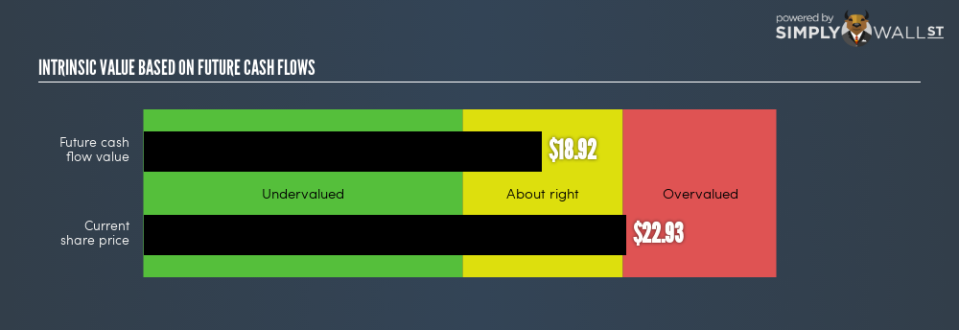Intrinsic Calculation For Old Republic International Corporation (NYSE:ORI) Shows Investors Are Overpaying

Valuing ORI, an insurance stock, can be daunting since these financial firms generally have cash flows that are impacted by regulations that are not imposed upon other industries. Industry-specific factors, such as gross written premiums are crucial in understanding how insurance companies make money. Emphasizing data points like book values, in addition to the return and cost of equity, can be beneficial for calculating ORI’s intrinsic value. Below I’ll look at how to value ORI in a reasonably effective and uncomplicated method.
Check out our latest analysis for Old Republic International
What Is The Excess Return Model?
Let’s keep in mind two things – regulation and type of assets. Financial firms operating in United States face strict financial regulation. Moreover, insurance companies generally don’t hold substantial amounts of tangible assets as part of total assets. As traditional valuation models put weight on inputs such as capex and depreciation, which is less meaningful for finacial firms, the Excess Return model places importance on forecasting stable earnings and book values.
How Does It Work?
The key belief for this model is that equity value is how much the firm can earn, over and above its cost of equity, given the level of equity it has in the company at the moment. The returns above the cost of equity is known as excess returns:
Excess Return Per Share = (Stable Return On Equity – Cost Of Equity) (Book Value Of Equity Per Share)
= (0.099% – 9.2%) x $16.88 = $0.13
Excess Return Per Share is used to calculate the terminal value of ORI, which is how much the business is expected to continue to generate over the upcoming years, in perpetuity. This is a common component of discounted cash flow models:
Terminal Value Per Share = Excess Return Per Share / (Cost of Equity – Expected Growth Rate)
= $0.13 / (9.2% – 2.9%) = $2.04
Combining these components gives us ORI’s intrinsic value per share:
Value Per Share = Book Value of Equity Per Share + Terminal Value Per Share
= $16.88 + $2.04 = $18.92
This results in an intrinsic value of $18.92. Given ORI’s current share price of US$22.93, ORI is currently priced higher than its intrinsic value. This means ORI isn’t an attractive buy right now. Pricing is only one aspect when you’re looking at whether to buy or sell ORI. Fundamental factors are key to determining if ORI fits with the rest of your portfolio holdings.
Next Steps:
For insurance companies, there are three key aspects you should look at:
Financial health: Does it have a healthy balance sheet? Take a look at our free bank analysis with six simple checks on things like leverage and risk.
Future earnings: What does the market think of ORI going forward? Our analyst growth expectation chart helps visualize ORI’s growth potential over the upcoming years.
Dividends: Most people buy financial stocks for their healthy and stable dividends. Check out whether ORI is a dividend Rockstar with our historical and future dividend analysis.
For more details and sources, take a look at our full calculation on ORI here.
To help readers see past the short term volatility of the financial market, we aim to bring you a long-term focused research analysis purely driven by fundamental data. Note that our analysis does not factor in the latest price-sensitive company announcements.
The author is an independent contributor and at the time of publication had no position in the stocks mentioned. For errors that warrant correction please contact the editor at editorial-team@simplywallst.com.

